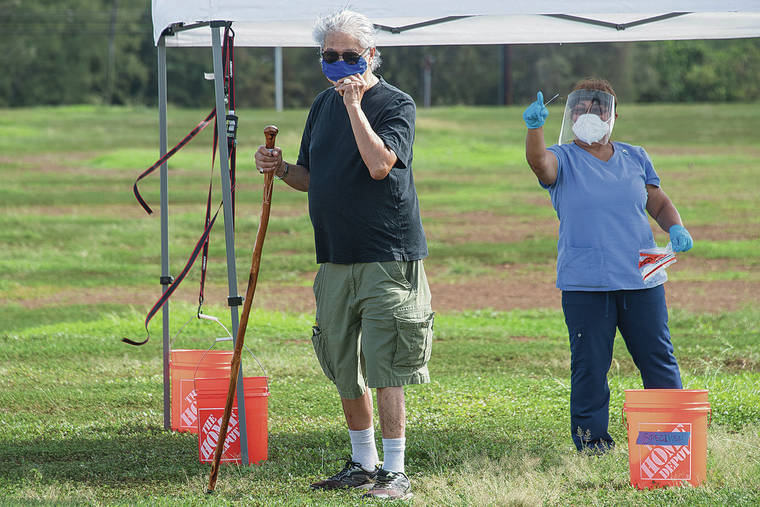Honolulu appears unlikely to advance to Tier 3

CRAIG T. KOJIMA / CKOJIMA@STARADVERTISER.COM
The upcoming holidays will be a challenge for officials to get residents to avoid gathering in large groups. Francis Evangelista took a self-administered virus test Wednesday at a COVID-19 testing location at Ewa Puuloa District Park.
With 125 coronavirus Opens in a new tab cases reported on Oahu, it appears unlikely that Honolulu will move this month to the next phase of economic reopening.
In fact, it could move backward, warns Honolulu Mayor Kirk Caldwell.
To move to Tier 3, which would allow gatherings of 10 (up from the current 5), before Thanksgiving, the island must maintain a seven-day average case count of 49 or fewer cases, and a seven-day average positivity rate of 2.49% or lower for 14 consecutive days. The seven-day average case count is 71 and the positivity rate is 2.7%.
“The next two weeks are critical. We’ve all seen what’s been happening the last couple of days. The trend is going up,” Caldwell lamented at a news conference Wednesday. “It’s hard to move into Tier 3 if we see this trend.”
Oahu moved to the less restrictive Tier 2 of the island’s four-tier economic recovery plan on Oct. 22, and must stay in that tier for four weeks. So far, Oahu hasn’t had two straight days below 50. It could revert back to Tier 1 if the daily case average exceeds 100 for two consecutive weeks.
Health officials reported 156 new coronavirus infections statewide — including 125 on Oahu, the first day since Oct. 9 of more than 100 new infections on the island — bringing the total since the start of the pandemic to 15,318 cases. No additional deaths were recorded Wednesday. The official death toll remains at 219.
Don't miss out on what's happening!
Stay in touch with breaking news, as it happens, conveniently in your email inbox. It's FREE!
“What we’re hearing is these cases, these clusters we’re seeing are from people gathering in more than five. A lot of it is probably in private homes around the island,” including a couple large parties on Halloween, he said. “Letting our guard down and thinking we’re different, we’re not. We generate the virus spread and then we all get hurt.”
“For the younger folks … you’re no more immune than anyone else. You may not have the same effects from the virus, but what happens if you get sick is our numbers go up,” he added. “That in turn affects our economy, your businesses and your children who want to get back to school again.”
Getting residents to avoid gathering in large groups during the upcoming holidays — Thanksgiving, Christmas and New Year’s Eve — will be challenging for government officials.
But the mayor insists that it is the only way the economy can recover.
“Without a healthy community, you don’t have a healthy economy,” Caldwell said. “If more and more people get sick with COVID-19, they’re not going to go out to have dinner, they’re not going to go shopping, they’re going to stay home and the economy remains sick.”
“And visitors won’t return if (these) numbers continue to go up.”
Caldwell is promoting a voluntary program to help small businesses create a COVID-safe economy. The campaign advertises businesses that complete a coronavirus safety checklist and adds them to an online directory of local businesses that are taking COVID-19 precautions and “putting the health and safety of customers and staff first.”
About 750 businesses already have signed up for the “Back on the Wave” campaign, which comes with free personal protective equipment and signage for participating businesses.
“Small businesses continue to be in dire straits,” said Sherry Menor-McNamara, president and CEO of the Chamber of Commerce Hawaii. “In fact, 40% of businesses cannot pay their rent or part of their rent. Forty percent of businesses experienced reduced revenues, even no revenues, 24% have indicated that they still cannot open. It’s going to take personal responsibility of individuals as well as businesses to do their part.”



